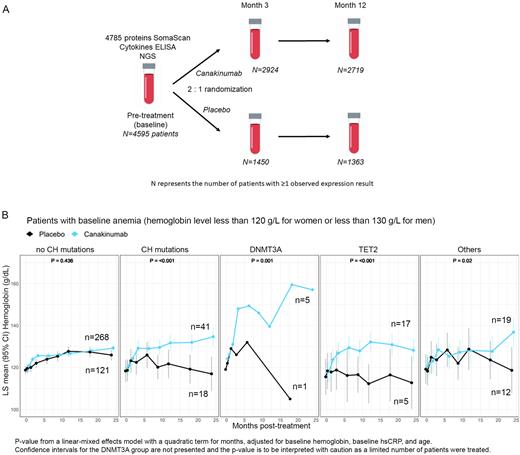Abstract

Canakinumab is a monoclonal antibody that directly neutralizes interleukin (IL)-1β. In the Canakinumab Anti-inflammatory Thrombosis Outcomes Study (CANTOS) - a randomized, double-blind, placebo-controlled trial that enrolled 10,061 patients with previous myocardial infarction and high-sensitivity C-reactive protein (hsCRP) levels ≥2 mg/L - canakinumab prevented recurrent cardiovascular (CV) events (Ridker et al. NEJM 2017). Anemia of inflammation (AI) presents with mild to moderate anemia in the setting of systemic inflammatory conditions. The pathogenesis of AI involves deregulation of iron homeostasis via hepcidin and inflammatory cytokines such as IL-1β, IL-6, and TNF-α, resulting in skewed myeloid differentiation and decreased erythrocyte lifespan via enhanced erythrophagocytosis (Ganz et al. NEJM 2019). A CANTOS exploratory study revealed that canakinumab reduces the incidence of anemia and improves hemoglobin levels (Vallurupalli et al. Ann Intern Med. 2020). Among mutations associated with clonal hematopoiesis (CH), patients with TET2 variants had fewer major adverse CV events than those without CH mutations (Svensson et al. JAMA Cardiol. 2022). CH mutations in TET2 were associated with higher IL-1β levels (Bick et al. Nature 2020), generating the hypothesis that inhibition of IL-1β may provide preferential benefits to patients with CH mutations.
To determine the association between CH mutations and clinical response to canakinumab and evaluate the underlying molecular mechanisms of anemia response, a proteogenomic study was performed in 13080 plasma samples from 4595 CANTOS participants, including highly multiplexed proteomics (4785 proteins) and targeted deep sequencing of CH mutations with variant allele fraction≥ 2% (Figure A). Longitudinal and cross-sectional analyses were performed in pre- and post-treatment samples from patients with at least one pre-treatment sample (baseline).
CH mutations were associated with older age, anemia at baseline, and higher baseline IL-6 and TNF-α levels (all OR's >1.4 and p<0.003). Among patients without baseline anemia, canakinumab treatment prevented incidental anemia, compared to those treated with a placebo (without CH mutation: HR=0.72; 95% CI=0.61-0.84; P < 0.001, with CH mutations: HR=0.77; 95% CI=0.49-1.19; P =0.24). In individuals treated with canakinumab, however, those with CH mutations were more likely to develop incidental anemia compared to patients without CH mutations (HR=1.56; 95% CI=1.18-2.07; P=0.002). Conversely, among patients with baseline anemia, canakinumab treatment significantly improved hemoglobin levels in patients with CH mutations compared to a placebo (P< 0.001), whereas a significant difference was not found in hemoglobin levels of patients without CH mutations (Figure B). Enhanced hemoglobin response over time to canakinumab was observed in patients with concurrent baseline anemia and CH mutations, particularly in DNMT3A and TET2, compared to no CH mutations (all CH mutations, DNMT3A and TET2,P = 0.022, 0.004, 0.078 respectively). We observed that canakinumab treatment reversed multiple nodes of abnormal erythropoiesis associated with AI. Canakinumab treatment was associated with lower hepcidin and inflammatory cytokines (IL-6 and TNF-α) and down-regulation of pathways for complement activation and phagocytosis, which may prolong RBC lifespan and promote erythropoiesis. Higher odds of having both an increase in hemoglobin and a decrease in hepcidin (OR=1.88; 95% CI=1.62 - 2.17; P<0.001 ) and both an increase in hemoglobin and a decrease in IL-6 (OR=3.46; 95%CI=3.00 - 4.00; P<0.001) were observed with canakinumab treatment compared to placebo. The characterization of proteomic profiles in patients with CH mutations revealed novel biological links in dysregulation of RBC homeostasis, cardiovascular risk biomarkers, inhibitory immune molecules, and bone morphogenetic protein antagonists, which were reversed by canakinumab treatment more significantly in patients with TET2 mutations. Collectively this data provides direct clinical evidence that patients with concurrent anemia and CH mutations can benefit from canakinumab treatment by suppressing CH-mediated activation of the IL-1β/IL-6 axis and reversing ineffective erythropoiesis via multiple mechanisms, and the type of CH mutations may be associated with distinct clinical and biological response.
Disclosures
Woo:Novartis Pharma AG: Current Employment. Lu:Novartis: Current Employment. Lewandowski:Novartis Institutes for BioMedical Research: Current Employment; Novartis Pharmaceuticals: Current equity holder in publicly-traded company. Ridker:Novartis: Research Funding. Ebert:Novartis: Research Funding; GRAIL: Consultancy; Skyhawk Therapeutics: Membership on an entity's Board of Directors or advisory committees; Exo Therapeutics: Membership on an entity's Board of Directors or advisory committees; TenSixteen Bio: Current equity holder in private company, Membership on an entity's Board of Directors or advisory committees; Deerfield: Research Funding; Celgene: Research Funding. Steensma:Novartis: Current Employment.
Author notes
 This icon denotes a clinically relevant abstract
This icon denotes a clinically relevant abstract
Asterisk with author names denotes non-ASH members.


This feature is available to Subscribers Only
Sign In or Create an Account Close Modal